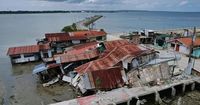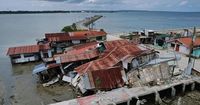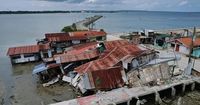On Friday, October 3, 2025, Typhoon Matmo barreled into the northern Philippines, adding a fresh layer of urgency and complexity to a country already reeling from a series of recent natural disasters. As Matmo—locally known as Paolo—made landfall in Dinapigue, Isabela province, it packed sustained winds of up to 130 kilometers per hour (81 mph), according to the Associated Press. The typhoon’s arrival forced authorities to suspend classes, evacuate thousands of residents from flood- and landslide-prone villages, and ban cargo and fishing vessels from venturing into the now-turbulent seas along its path.
Matmo’s northwestward trajectory took it across a vast agricultural valley and into the mountainous provinces of northern Luzon. By nightfall, the storm had weakened somewhat but still maintained sustained winds of up to 110 kph (68 mph), with gusts reaching 165 kph (102 mph), as reported by AP and other outlets. Floods were reported in several affected regions, and power outages hit both Isabela and the neighboring Aurora province. Over 8,000 villagers were evacuated as a precaution, local officials confirmed.
For the Philippines, a nation that sits squarely on the Pacific “Ring of Fire” and faces about 20 typhoons and storms each year, Matmo was the 16th tropical cyclone to strike in 2025. The timing couldn’t have been worse. Just days earlier, on Tuesday night, a powerful 6.9-magnitude earthquake rattled the central province of Cebu, leaving at least 72 people dead and injuring more than 550—most in the city of Bogo and outlying towns. More than 5,000 homes were damaged by the quake, and many residents, fearful of aftershocks, chose to camp out in parks, grassy clearings, and even on sidewalks despite intermittent rain. “We can’t blame people if they refuse to return home … there were too many aftershocks and some were really strong,” Public Works Secretary Vivencio Dizon said during a news conference in Manila. “They don’t want to go anywhere with a roof.”
To address the urgent needs of those displaced by the earthquake, Dizon announced that about 1,000 tents would be set up with help from the Red Cross in Bogo and surrounding towns starting Saturday, October 4. The efforts to provide shelter and aid were made even more challenging by the arrival of Typhoon Matmo, which complicated logistics and raised fears of further flooding or landslides in already vulnerable areas.
The typhoon was not expected to directly affect the central region hit by the earthquake, but the cumulative toll of disasters weighed heavily on the country’s emergency response systems. According to forecasters, Matmo was expected to move into the South China Sea by Saturday, October 4, heading on a path toward southern China. The Hong Kong Observatory projected that Matmo would pass near Hong Kong over the weekend, continuing toward Hainan Island and Guangdong province.
Matmo’s impact was the latest in a string of weather-related calamities. Just a week prior, another storm named Bualoi swept through the Philippines, causing at least 37 deaths and displacing thousands before moving on to Vietnam. There, Bualoi left 49 dead and inflicted an estimated $485 million in economic damages, according to Vietnamese authorities. And before Bualoi, Super Typhoon Ragasa—heralded as the world’s strongest tropical cyclone of the year at its peak—brushed past the Philippines, causing several fatalities before making landfall in southern China.
The relentless sequence of disasters has tested the resilience of communities and the capacity of government agencies to respond. In the immediate aftermath of Typhoon Matmo, local officials scrambled to assess damage, restore power, and deliver aid to those in need. Schools remained closed in affected regions, and authorities maintained bans on maritime activities as rough seas persisted. The country’s weather agency warned that, despite weakening, Matmo still posed a threat, with the potential to generate "life-threatening" tidal surges of up to three meters (10 feet) and to intensify seasonal monsoon rains. There was even concern that Matmo could re-strengthen into a typhoon as it crossed the South China Sea toward China.
For residents in northern Luzon, the experience of evacuation and uncertainty was all too familiar. The archipelago’s geography—a sprawling collection of more than 7,000 islands—makes it especially vulnerable to both seismic and meteorological hazards. The Philippines’ location on the Pacific “Ring of Fire” brings frequent earthquakes and volcanic eruptions, while its position in the warm waters of the western Pacific ensures a steady stream of typhoons. According to the Associated Press, Matmo was the 16th such storm to hit the country in 2025 alone.
Meanwhile, in Cebu and surrounding areas affected by the recent earthquake, the recovery process was slow and fraught with anxiety. Many residents remained outdoors, too frightened by continuing aftershocks to risk returning to damaged homes. The government’s plan to deploy tents and coordinate with the Red Cross offered some hope, but the threat of further weather disruptions loomed large.
As Matmo moved toward the South China Sea, international attention shifted to its projected impact on southern China, including Hong Kong, Hainan Island, and Guangdong province. The Hong Kong Observatory issued warnings and tracked the storm’s progress closely over the weekend of October 4-5. While the Philippines braced for the next challenge, neighboring countries prepared for the possibility of heavy rain, flooding, and wind damage from Matmo’s passage.
In the broader context, the events of late September and early October 2025 highlight the Philippines’ ongoing struggle with natural disasters. The combination of frequent typhoons, powerful earthquakes, and the ever-present risk of landslides and flooding creates a cycle of vulnerability that tests the resolve of communities year after year. Government officials, humanitarian organizations, and ordinary citizens alike are called upon to respond swiftly and compassionately, even as resources are stretched thin by repeated emergencies.
Despite these hardships, the resilience of the Filipino people shines through. From the swift evacuation of at-risk villages to the setup of emergency shelters and the coordination of disaster response teams, there is a sense of solidarity and determination to weather each new storm—literally and figuratively. As the country moves forward, the lessons learned from Typhoon Matmo, the Cebu earthquake, and other recent calamities will inform future efforts to build safer, more disaster-resilient communities.
For now, the Philippines faces the daunting task of recovery and preparation, knowing that in this part of the world, the next challenge is never far away.






